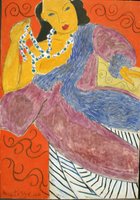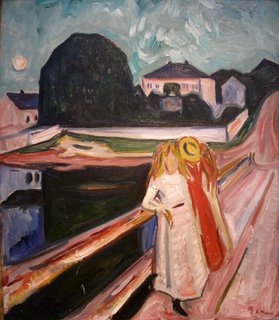The permanent collection is small, but extraordinary by any standard. Included are important works by Mondrian, Picasso, Caravaggio, El Greco, Rembrandt, Monet, Gainsborough, and Rubens, among many other works by European artists.There is also a small collection of Greek, Roman, and Egyptian antiquities. Though small, the Asian collection is as extraordinary as the works by European masters.
 The collection includes one of my favorite modern paintings, "Abstraction" by Piet Mondrian. The painting is a grid consisting of straight horizontal and vertical lines and rectangular shapes; Black, white, and the primary colors of red, yellow, and blue are used abstractly. Mondrian began the painting in 1939 in London and finished it in New York in 1942. A Dutchman, he had fled from Paris to London and then to New York to escape the spreading danger of World War II. I don’t know what the painting means, but I know I have liked it from the first time I saw a picture of it in a book about modern art.
The collection includes one of my favorite modern paintings, "Abstraction" by Piet Mondrian. The painting is a grid consisting of straight horizontal and vertical lines and rectangular shapes; Black, white, and the primary colors of red, yellow, and blue are used abstractly. Mondrian began the painting in 1939 in London and finished it in New York in 1942. A Dutchman, he had fled from Paris to London and then to New York to escape the spreading danger of World War II. I don’t know what the painting means, but I know I have liked it from the first time I saw a picture of it in a book about modern art.  The Kimbell owns two Picassos: “Man Smoking a Pipe” and “Nude Combing Her Hair.” We are told that the model for “Nude” was Ferdnande Olivier who came into Picasso’s life in 1902 and was the person who persuaded him to leave his Blue Period. It was painted about the time Picasso met Matisse.
The Kimbell owns two Picassos: “Man Smoking a Pipe” and “Nude Combing Her Hair.” We are told that the model for “Nude” was Ferdnande Olivier who came into Picasso’s life in 1902 and was the person who persuaded him to leave his Blue Period. It was painted about the time Picasso met Matisse.  The museum’s only Matisse, “L’Asie (Asia)” was painted much later, near the end of the artist’s life. In September I saw again the two large Matisse “Dancers” at the Hermitage in St. Petersburg.
The museum’s only Matisse, “L’Asie (Asia)” was painted much later, near the end of the artist’s life. In September I saw again the two large Matisse “Dancers” at the Hermitage in St. Petersburg.“Girls on a Pier” is one of several versions of the same scene by Edvard Munch, the Norwegian painter. Anybody who has ever been captivated and mystified by Munch’s “The Scream” will have the same response to “Girls.” Anxiety is the dominant mood of both paintings. The blank face of the girl who seems to turn and face the viewer is haunting.

Camille Pissarro’s “Near Sydenham Hill” is a painting I could enjoy seeing every day. One of the leading painters in the French Impressionist Movement, In 1871 Pissarro moved from Paris to England with his wife and two children to escape war. His friend Monet had already made the same move. I wonder if a French painter looking at an English landscape sees it differently from the way he might see it if he had always lived there. I often wonder when I am looking at the countryside in a foreign place if I am seeing the same things natives to the place are seeing...which makes me wonder how we can ever be objective when we look at anything.

Monet was back in France and another war was raging when he painted “The Willow Tree.” In this war he refused to leave his gardens at Giverny. His only surviving son was in constant danger at the front, and the fighting was so close to Giverny that at times Monet could hear artillery fire as he painted. He was losing his eyesight, and this painting (one of ten of the same tree that stood on the bank of his lily pond) was one of the last easel-sized paintings he did.

The Kimbell owns Rembrandt’s “Head of A Young Jew.” Rembrandt was not a Jew. What is he trying to say in the painting about the young man? Would it be the same if Rembrandt had not known the man was Jewish when he was doing the painting? Does Rembrandt consider the man kind...or cunning...or...?


Among the Asian works in the museum is this Japanese Gigaku Mask. It depicts Karura, one of the fourteen characters in a religious dance-drama that was performed for the royal court at Buddhist temple ceremonies from the 7th to the 10th century. In the performance, Karura is a mythical giant bird that protects the Buddhist faith.
No comments:
Post a Comment